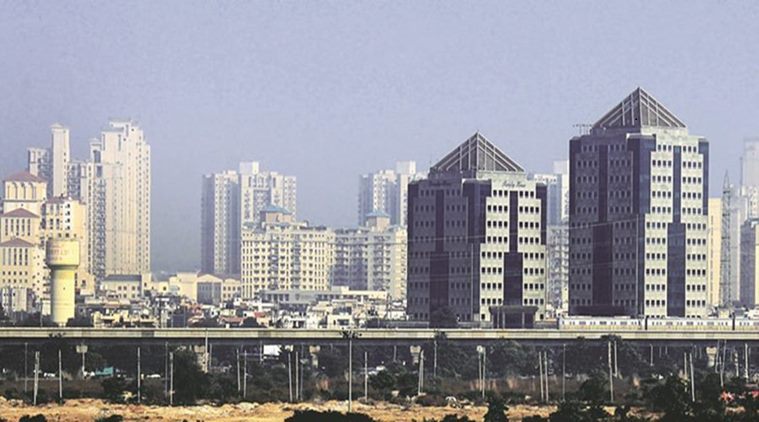‘Other successful developing Asian economies have been more equal than India’
James Crabtree talks about the Indian economy’s crony capitalism and alarming inequalities, and the country’s urgent need for sustainable urbanisation.

Gurgaon cityscape: Urban migration may be a solution rather than a problem. (Express photo/Manoj Kumar)
You have focused on crony capitalism in India, growing inequalities and India’s new gilded age. Have some new crony capitalists replaced the old? Have they been reined in at all?
Billionaire Raj focuses on the new super-rich. It identifies fault-lines in India’s economy, one of which is crony capitalism. This became a huge problem as India re-globalised its economy in the mid-2000s, during the “season of scams”. Since then, under Narendra Modi, many of the worst scams have stopped, but corruption remains a huge problem — a battle which is, at best, half won.
In the West, we see Donald Trump, a businessman, becoming president of the US, and no disquiet is felt when entrepreneurs occupy public office. In India, at least publicly, governments have been wary of businessmen, and of business. Is it hypocritical, or is it just that crony capitalism is viewed differently?
In the US, Trump is unusual historically. Not many tycoons have held high political office. In India, it is arguably more common for big businessmen to hold office, or indeed vice versa. You have Vijay Mallya or Naveen Jindal or Anil Ambani — tycoons who have sat in Parliament. But you also have politicians who set up or control businesses for their own ends. India’s economy is complex, but it is clear that in some areas, there is a nexus between business owners and politicians. It rarely acts in the public interest.
Over time, many robber barons have graduated to running professionally managed firms or industrial groups, and also turned philanthropists. Top businessmen are moving up the pecking order of the global rich lists. But the dearth of compassionate capitalism and the widening gap between the top one per cent and the rest have been criticised.
Read | Grime Beneath the Glitter
India has seen huge increases in wealth and income inequality over recent years, even as it has lifted hundreds of millions out of poverty. Inequality comes partly from business success at the top, which we should admire. Sometimes it is caused by structural changes like globalisation or urbanisation, and by cronyism. The point is that India should be worried about a huge and growing gap between rich and poor. Other successful developing Asian economies have been more equal than India.
In the last four years, has Narendra Modi reset the balance of power between politics and business, especially with the targeting of those who game the system? You write that Naveen Jindal told you, “we used to go all out and now we will be very conservative”. What does this signify?
India’s tycoons — the “promoters” — have had a bruising period. Many took on too much debt and found their industrial projects running into trouble after the corruption scandals of the 2000s. Now, they are being cautious. Private sector investment has been unusually low for years. Banks are weighed down by $150 billion in bad debts. This is a huge problem, and Modi has done too little to solve it. Whoever wins the next election in 2019 would need to act quickly to get India’s industrial economy moving again.
Many reckon that Indian institutions, including regulatory, have been weakened in recent years. Economist Dani Rodrik had said that without major changes to institutions, rapid growth would be unsustainable. Having analysed the growth of the tiger economies and China, do you agree?
I agree with Rodrik that India faces huge challenges. But I am optimistic, in theory at least. India is not Russia. Its economy has huge strengths. It is not an oligarchy, although I feel its business elite is in many ways too powerful, and a more competitive market economy is desirable. That said, many countries have been through similar periods of early industrialisation, cronyism and huge inequality — America in the 1880s, or South Korea in the 1970s. These countries managed to develop. With wise and brave policy, I see no reason why India cannot. Its just not going to happen by accident.
You have also written that in 2014 people voted for a reformist leader who has half delivered, and has been far less radical and courageous than was expected. Against this backdrop, with growing polarisation, can India leave behind the perils of inequality and crony capitalism?
Again, I think it can, but not without radical action to fix the three problems I identify in the Billionaire Raj: the huge growth in inequality which has accompanied the rise of India’s new super elite; the ongoing cancer of crony capitalism; and, the boom and bust cycle of its industrial economy, along with the present “twin balance sheet” problem of heavily indebted big companies and banks laden with bad loans.
What are the key elements of a hybrid economic model which, you say, can sustain high growth over the next few decades?
India needs to industrialise on the lines of an East Asian model. This means development of infrastructure and export-focussed manufacturing in particular. India can’t replicate the China story, but it can move in that direction. India also needs radical and sustainable urbanisation, reducing by hundreds of millions the numbers working in its fields, and helping them move to cities. And it needs vastly better systems of basic social support to develop human capital, which means investment in education and health. Some of this must be paid for by ensuring that more people pay taxes — especially those at the very top, who have done best of all.
For all the latest Lifestyle News, download Indian Express App






















No hay comentarios:
Publicar un comentario